World Guides Travel Blog
June 2014
This is where we let you know all about what's going on with our website and the world of travel, with destination reviews, current travel news and topical travel-related stuff to discuss with your friends. Please let us know if you want to comment on anything -
Contact us.
June 27, 2014
SUN, SEA, SAND... AND ART
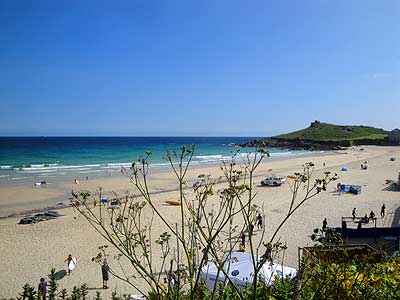
Last week, I discovered that a sandy, sun-kissed paradise does indeed exist in England. I also found out quite a lot about modern art. It is not often you can combine the two, culture and a beach holiday in one fell swoop, but the Cornish town of
St. Ives succeeded admirably on both counts.
For a start, it was a gloriously hot four days. The sort of weather you usually have to board a plane to enjoy. St. Ives is said to have its own micro-climate, which adds a couple of degrees to the temperatures you would normally expect in the south-west of England at this time of year. The town also has plenty of sea, surf and sand. Porthmeor Beach has fine golden sand and its own surf school. Porthminster Beach offers less in the way of surf, but more in the way of shelter. It is possible to spend hours just gazing out to sea, taking in the view of Godrevy Lighthouse on the horizon. Tiny Porthgwidden Beach has all the charm that you would expect of a hidden cove, nestled beneath the slopes of St. Ives 'Island'. With its brightly coloured beach huts, it is hard to imagine a more quintessentially British holiday scene.
That said, I hadn't really come to St. Ives to lie on a beach (although it would have been churlish not to). I'd come with a mission in mind. I wanted to find out about how this quaint Cornish town became a world-renowned artistic centre. First stop was the Tate Gallery, home to modern art, and which was fortuitously celebrating its 21st anniversary. I strolled around the galleries and admired the works of such artists as Ben Nicholson, Barbara Hepworth, Bernard Leach and Peter Lanyon. Afterwards, with the sun still shining, I rested amongst the sculptures and ferns of Barbara Hepworth's inspirational garden and studio.
I chose to stay in Zennor, in a converted chapel guesthouse that has unrivalled views of the sea to one side and the high moorland to the other. This tiny village was home to two of the area's most renowned post-war artists, Bryan Wynter and Patrick Heron, who were said to have been heavily influenced by its dramatic rocky outcrops.
On my last evening, as I strolled along to Zennor Head to admire the setting sun, it was clear to me that St. Ives has always been a special place. For those avant garde artists of the last century, it was the allure of the light and the landscape that surrounds this part of the Cornish coast. For tourists and St. Ives' thriving arts colony today, that same allure holds strong. I shall certainly be heading back sometime soon.
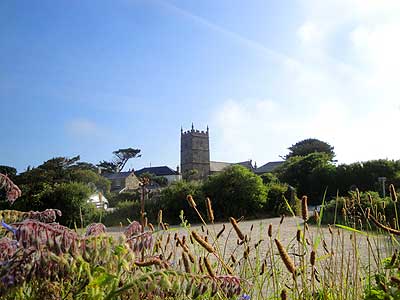
Photo showing the village of Zennor and its small church.
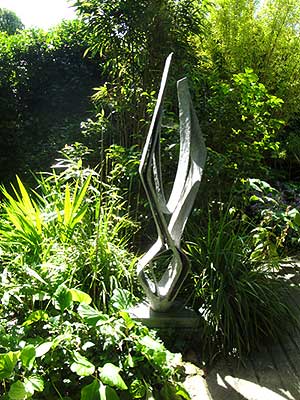
Sculpture at the St. Ives Barbara Hepworth Museum and Gardens.
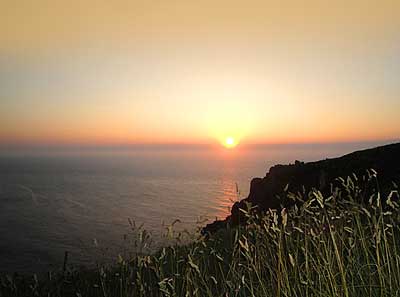
Image of the sun setting off Zennor Head.
Posted by Sue at 13:40:39 on 27/6/2014
June 24, 2014
GETTING IN THE MOOD FOR MIDSUMMER

The sun is shining here in
Somerset and, for once, it actually does feel like summer. It is enough to put you in the mood for the summer solstice, an event that will be marked this Saturday with midsummer celebrations in abundance.
In the early hours of Saturday, Stonehenge will be taken over by thousands of pagans, druids and assorted revellers as they gather to watch the sun rise over the stones. In nearby Avebury, which is home to an impressive Neolithic henge and stone circle, it is likely to be just as busy.
In
Cornwall, summer solstice events take on a distinctly celtic feel. The best place to head for is
Penzance, where the ancient Golowan festival. Revived several years ago by local schoolchildren, these days, it is still going strong. In fact, it is become a marathon ten-day celebration of music and art.
Summer solstice celebrations aren't confined to this part of the world. In Scandanavia, midsummer is celebrated with maypoles and much dancing and, one suspects, an awful lot of good old-fashioned partying. The streets of
Stockholm become uncannily empty as city dwellers head into the countryside in search of summer solstice fun.
Meanwhile, back in Somerset a group of runners and walkers have decided to celebrate the eve of midsummer in a special way, with their very own Sunchase. Their chase for the solstice sunrise will take the form of a 24-hour relay challenge over a 117-mile / 188-km ring around the Mendips, arriving in Burrington Combe in the early hours of Saturday - hopefully, just in time to see the sun rise.
Posted by Sue at 15:09:35 on 24/6/2014
June 19, 2014
FOOTBALL FEVER
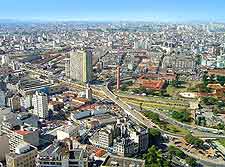
You might think that a trip to Brazil is out of most football fans' league. This South American country is, after all, a long way from Europe. Crime rates in the country are traditionally seen as high, too, scaring off many a potential tourist in the past. But apparently such concerns have been set to one side in the name of football fever. English football fans have been booking hotels in key football-hosting Brazilian cities in their droves.
In total, 12 cities will host Brazil's World Cup matches.
Manaus, which will host England's first group match against Italy, is proving to be popular. Located right in the middle of the Amazon rainforest, fans might be a touch surprised by the city's penchant for European architecture.
Sao Paulo also gets to host an England game. As the largest city and economic hub of Brazil, it is already a popular destination for European holiday makers. No doubt, it is reputation as the 'city of drizzle' will strike a chord with English football fans.
Belo Horizonte, which will host England's final group game, has been the subject of huge interest from football fans - no doubt because it happens to be home to one of the best stadiums in Brazil, the Estadio Mineirao. The city is also home to around 12,000 'botecos' or bars, making it perhaps the best place in Brazil to get a post-match drink.
Fans visiting
Recife to watch the winners of England's group in the second round might be unaware that the city is famous not just for its football. Known as the 'Brazilian Venice', it is also acquired a reputation for being one of the most dangerous places in the world to don your swimming costume. Its high population of sharks has led to dozens of shark-related incidents in recent decades.
Whilst English tourists will inevitably focus most of their attention on the football pitch, they are also being encouraged to spread their nets wider, to explore some of Brazil's most popular tourist attractions. There'll be a host of festivals and street fiestas, too. It would indeed be a shame not to join in.
Posted by Sue at 9:57:38 on 19/6/2014
June 9, 2014
DISCOVERING THE HISTORY OF D-DAY
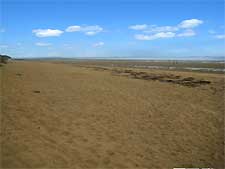
A few years ago, we spent part of our holiday touring the Normandy beaches. In the heat of the August midday sun, we paddled in the shallows of La Manche, wending our way from one sandy beach to another. Seagulls wheeled overhead and, as afternoon turned to evening, we found ourselves almost alone. It was a fascinating experience; it was also a sobering one. Today, 70 years on, many more people will be seeking to relive the history-changing events of 6th June, 1944, discovering perhaps that the poignancy of these historic sites doesn't seem to fade, but instead grows ever stronger.
On that holiday, our journey took us from Sainte-Mère Eglise where airborne paratroopers landed on the eve of D-Day, to Utah Beach, the site of one of two American landings. Along the coast is Omaha Beach, widely regarded as the site of one of D-Day's bloodiest battles. From there we went to Gold Beach, which extends from La Riviére through to Arromanches, a town that has very visible evidence of the momentous events of World War Two - several of the concrete pontoons of the Mulberry harbour remain, defying time and the weather. A trip over Pegasus Bridge brought us to Ouistreham, codenamed Sword Beach. A stroll around this pretty seaside resort soon unearthed a legacy of memorials and ruined wartime fortifications.
When there is so much to see and you've only got limited time, you've no alternative but to be selective about the museums you visit. We chose to pop into Musée America Gold Beach at Ver-sur-Mer, and were rewarded with a museum that ably recounts the events that overtook this British beachhead on D-Day. A plethora of museums in the area are dedicated to everything from the airborne and tank divisions involved in the invasion to the underwater wrecks found in the coastal landing area.
There is no doubt that a knowledgeable tour guide would have been useful at times. It would perhaps have meant we didn't miss out on some of the lesser known details of D-Day. That said, our independent tour had a lot going for it - allowing us to find out more about the epic events that took place during the invasion and giving us ample opportunity to explore the peaceful countryside and coastline of this historic French region.
Posted by Sue at 10:39:07 on 9/6/2014
June 1, 2014
THE MOST DANGEROUS RACE ON EARTH
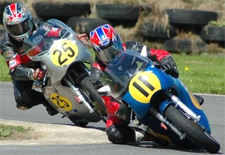
For a couple of weeks each May, the Isle of Man echoes not to the sound of seagulls, but to the exhaust pipes of thousands of motorcycles. Why? Because this small island, which is perched off the coast of northern Britain, happens to be home to what is widely acknowledged as one of the greatest - and perhaps most dangerous - racing events in the world.
The Isle of Man TT (Tourist Trophy) races have captured peoples' imaginations for over a hundred years. Their allure undoubtedly comes from the fact that the racers battle it out not on well-manicured tracks but on public roads. The Mountain Course comes complete with bends, bumps and brick walls - all of which racers face at eye-watering speeds of up to 200mph. Add spectacular scenery into the equation and you can see why the Isle of Man TT incites so much passion in the motorcycle world.
Top spectator spots on the island include the iconic TT Grandstand in Douglas, where you can get to see heroes of the motorcycle racing world start and finish in style. In recent years, temporary 'fanzone' grandstands have also been erected to make more of the viewing points at Ballaugh, Creg-ny-baa and Nobles Park. Then there are iconic spots like Braddan Bridge, on the outskirts of Douglas, or Sulby Straight, the longest straight section of road on the course. Only a few places on the course have restricted access and these are for obvious safety reasons.
Until this year, most of the pre- and post-race action has tended to centre on Douglas, a town that, for the rest of the year, is part-seaside resort and part-working harbour. This year, though, attempts have been made to lure visitors to the other side of the island with Motofest, a new festival held in Jurby. If successful, the festival could become a regular feature on the TT calendar.
Posted by Sue at 19:43:29 on 1/6/2014
 Last week, I discovered that a sandy, sun-kissed paradise does indeed exist in England. I also found out quite a lot about modern art. It is not often you can combine the two, culture and a beach holiday in one fell swoop, but the Cornish town of St. Ives succeeded admirably on both counts.
Last week, I discovered that a sandy, sun-kissed paradise does indeed exist in England. I also found out quite a lot about modern art. It is not often you can combine the two, culture and a beach holiday in one fell swoop, but the Cornish town of St. Ives succeeded admirably on both counts.


 The sun is shining here in Somerset and, for once, it actually does feel like summer. It is enough to put you in the mood for the summer solstice, an event that will be marked this Saturday with midsummer celebrations in abundance.
The sun is shining here in Somerset and, for once, it actually does feel like summer. It is enough to put you in the mood for the summer solstice, an event that will be marked this Saturday with midsummer celebrations in abundance. You might think that a trip to Brazil is out of most football fans' league. This South American country is, after all, a long way from Europe. Crime rates in the country are traditionally seen as high, too, scaring off many a potential tourist in the past. But apparently such concerns have been set to one side in the name of football fever. English football fans have been booking hotels in key football-hosting Brazilian cities in their droves.
You might think that a trip to Brazil is out of most football fans' league. This South American country is, after all, a long way from Europe. Crime rates in the country are traditionally seen as high, too, scaring off many a potential tourist in the past. But apparently such concerns have been set to one side in the name of football fever. English football fans have been booking hotels in key football-hosting Brazilian cities in their droves. A few years ago, we spent part of our holiday touring the Normandy beaches. In the heat of the August midday sun, we paddled in the shallows of La Manche, wending our way from one sandy beach to another. Seagulls wheeled overhead and, as afternoon turned to evening, we found ourselves almost alone. It was a fascinating experience; it was also a sobering one. Today, 70 years on, many more people will be seeking to relive the history-changing events of 6th June, 1944, discovering perhaps that the poignancy of these historic sites doesn't seem to fade, but instead grows ever stronger.
A few years ago, we spent part of our holiday touring the Normandy beaches. In the heat of the August midday sun, we paddled in the shallows of La Manche, wending our way from one sandy beach to another. Seagulls wheeled overhead and, as afternoon turned to evening, we found ourselves almost alone. It was a fascinating experience; it was also a sobering one. Today, 70 years on, many more people will be seeking to relive the history-changing events of 6th June, 1944, discovering perhaps that the poignancy of these historic sites doesn't seem to fade, but instead grows ever stronger. For a couple of weeks each May, the Isle of Man echoes not to the sound of seagulls, but to the exhaust pipes of thousands of motorcycles. Why? Because this small island, which is perched off the coast of northern Britain, happens to be home to what is widely acknowledged as one of the greatest - and perhaps most dangerous - racing events in the world.
For a couple of weeks each May, the Isle of Man echoes not to the sound of seagulls, but to the exhaust pipes of thousands of motorcycles. Why? Because this small island, which is perched off the coast of northern Britain, happens to be home to what is widely acknowledged as one of the greatest - and perhaps most dangerous - racing events in the world.